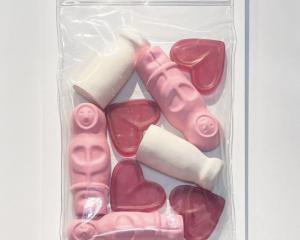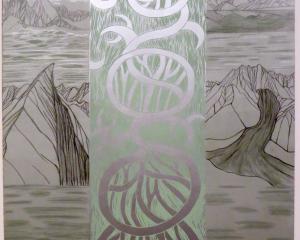With ''Menagerie'', The Artist's Room presents an exhibition, by nearly 30 artists, of work connected, either directly or loosely, with animals. There is much here to be seen and appreciated, with many fine two- and three-dimensional works.
Many of the best two-dimensional pieces are monochromatic. These include two bold, effective charcoal works by Jon Thom, Jane Crisp's charming ''Heron Princess'', and an extraordinary boldly crafted wolf by Isaac Leuchs. Among other wall pieces are fine studies of farmer and farmed as blueprints by Barry Ross Smith, some mixed-media surrealism from Margaret Silverwood, and a Japanese-inspired tiger linocut by Patrick Bishop.
Tony Cribb's humour has expanded from his ''Tin Man'' to include several warm and friendly pieces, notably ''Barely There Bear''. Celia Mendes's photographs and Inge Doesburg's masterful dog studies are also of note. Among the sculptural pieces, Donna Demente's dog masks are eye-catching, as is an impressive and cheeky copper kea by Nick Dryden. A fine humorous statue of dog walkers by Nic Clegg also stands out.
Finally, note must be made that all of The Artist's Room's staff have produced work that is not out of place in this display. Cath Garrett's work is already well-known, but both Michelle Chalklin-Sinclair and Katherine Garbutt have also produced good work for this exhibition.
Gary Blackman has spent much of his life as a photographer. Over the best part of six decades, he has slowly moved from his own description of himself as a ''spare-time photographer'' to being an important but often sadly overlooked master at his craft.
Blackman's great skills include his ability to dispassionately spot in the ordinary that which is extraordinary. His images set apart moments and nuances of a city (and many of his works concern the facets of cities - their buildings and people), turning them from half-glanced, forgotten scenes into memorable definitions of the day. Blackman describes some of his images as ''happy accidents''; the comical ''chin legs'' of ''Melbourne step'' and precisely selective focus of ''Rakaia Bridge'' falling into this category.
The artist's current exhibition consists of work from the last decade, and more specifically of work while Blackman was making a transition to digital photography. Most of the images make use of a generally muted palette, and in some cases are almost monochromatic. Where colour does appear more strongly, such as the busy highlights of ''Mary Newton Gallery'', it is used with distinct, emphatic purpose.
The artist's Wellington scenes, ''Iron walk'' and ''Iron profile'', in particular, impressively capture the atmosphere of the city at dusk.
Emilie Truscott uses the traditional surrealist technique of working as much as possible from inner thoughts, producing images which are guided as much by the artist's subconscious as by her artistic eye.
The resulting collages fit within a long line of cut-up art, tracing back to the artist's stated influences, Dali and Kahlo, but perhaps more to Max Ernst. Truscott's images, like those of Dunedinite Peter Lewis, work by drawing congruence from found images to produce works which become gestalts - wholes greater than the sum of their parts.
The term gestalt links also to Truscott's academic training in psychology, and her works - with their subconscious linkages between apparently mundane items - are perhaps as strongly influenced by social scientists such as Berger and Luckmann and philosophers such as Foucault as by art history.
Truscott's images are generally less rigorously cohesive than either her contemporary, Lewis, or her predecessor Ernst, but this looseness allows greater interpretation of the works by the viewer. It is telling that perhaps the most compelling of the pieces approaches the truly abstract, with its mosaic created from photographs of brightly hued interstellar nebulae. Here, object turns from trivial and mundane to amorphous, forcing the viewers mind to turn totally to its own inner thoughts.







![Untitled (c. mid 1990s, [pink 3]), by Martin Thompson, 415mm×590mm. Photo: courtesy of Brett...](https://www.odt.co.nz/sites/default/files/styles/odt_landscape_small_related_stories/public/story/2024/02/untitled_pink_3.jpg?itok=Q0aQrc9o)




